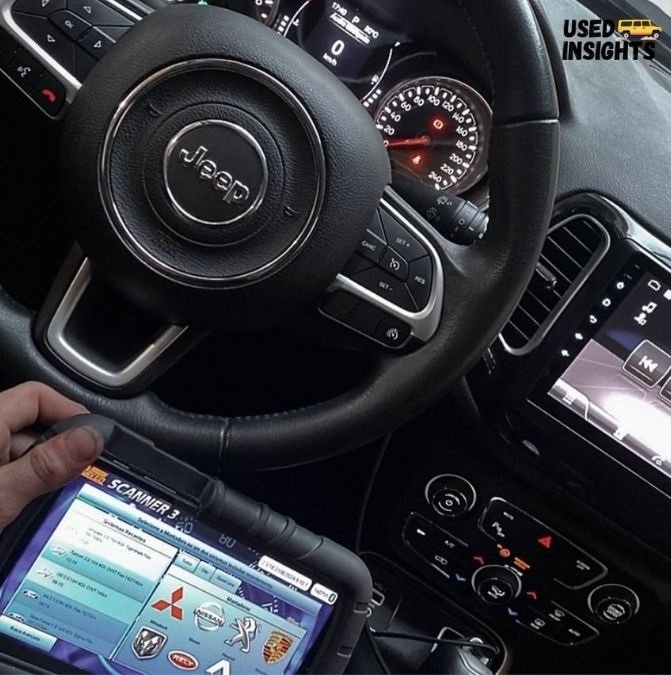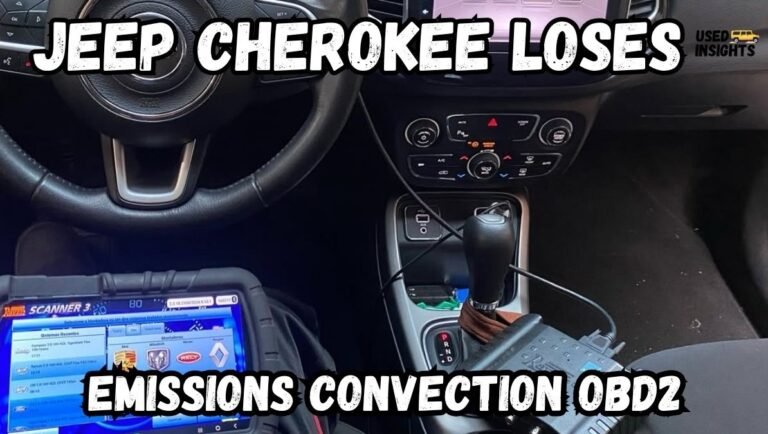The Jeep Cherokee stands as a legendary choice for adventure seekers and reliability enthusiasts alike. Despite its stellar reputation for off-road capability and durability, newer Cherokee models have encountered significant challenges with emissions control systems and OBD-II diagnostic functions.
These complications not only compromise vehicle performance and dependability but also contribute to environmental concerns. If you’re currently dealing with these frustrating issues and seeking comprehensive solutions, you’ve found the right resource.
This detailed guide explores the root causes behind emissions control failures and OBD-II malfunctions in Jeep Cherokee vehicles. We’ll examine their environmental and performance impacts, share real owner experiences, and provide actionable solutions to restore your Cherokee’s optimal operation.
Understanding Jeep Cherokee Loses Emissions Convection OBD2
What Causes Emissions Control Problems?
Emissions control system breakdowns in Jeep Cherokee vehicles stem from the inability to properly manage and process exhaust gases according to federal standards. When your Cherokee’s emissions system malfunctions, the Engine Control Unit (ECU) triggers various warning indicators including check engine lights, system not ready alerts, or emissions test failure notifications on your instrument cluster.
Excessive exhaust emissions pose serious environmental threats, creating legitimate concerns for vehicle owners and regulatory agencies. The primary culprits behind emissions control failures include malfunctioning catalytic converters, defective Exhaust Gas Recirculation (EGR) valves, and compromised emission-related sensors throughout the system.
Catalytic Converter System Breakdown
How Catalytic Converters Function
The catalytic converter serves as your Cherokee’s primary emissions processing component, utilizing advanced chemical reactions to transform harmful exhaust gases into less dangerous compounds.
Diesel Cherokee engines produce carbon monoxide (CO), hydrocarbon (HC), and nitrogen oxide (NOx) gases that severely impact air quality. Federal regulations mandate specific emission standards for diesel-powered vehicles, making a properly functioning catalytic converter absolutely essential.
Common Catalytic Converter Failure Modes
Catalytic converter deterioration occurs through several mechanisms including physical impact damage, catalyst contamination, or component degradation over time. Contaminants like engine oil leaks or coolant seepage can permanently damage the converter’s internal structure. External damage from road debris or collision impacts can also render the unit ineffective.
Most catalytic converters maintain functionality for approximately 100,000 miles, while Diesel Exhaust Fluid (DEF) catalysts require periodic replacement based on mileage intervals.
Exhaust Gas Recirculation (EGR) Valve Complications
EGR System Operation
The EGR valve enhances NOx emission reduction efficiency by redirecting a portion of combusted exhaust gases back into the engine’s combustion chamber. This process reduces combustion chamber temperatures, significantly decreasing NOx formation during the fuel burning process.
EGR valve failure results in elevated NOx emissions, directly contributing to atmospheric pollution.
Typical EGR Valve Problems
Frequent EGR valve issues include carbon buildup blockages, valve sticking, and complete valve failure. Carbon deposits accumulate on valve surfaces over time, restricting exhaust gas flow and compromising system effectiveness. A malfunctioning EGR valve creates unpredictable engine performance and often requires complete valve replacement to restore proper operation.
Emission Sensor Malfunctions
Modern Cherokee vehicles incorporate multiple sophisticated sensors including oxygen sensors, mass airflow sensors, and temperature monitoring devices that ensure optimal engine operation while minimizing emissions output. When any of these critical sensors begins malfunctioning, the ECU loses its ability to maintain proper air-fuel mixture ratios.
Consequently, the engine produces significantly higher emission levels than designed specifications. These sensors also directly influence fuel efficiency and overall performance characteristics. Sensor replacement typically resolves most emission-related diagnostic issues.
OBD2 Diagnostic System Problems Related to Emissions
Understanding OBD2 Emission Testing Issues
OBD-II system malfunctions prevent proper vehicle diagnostics and create significant obstacles during mandatory emissions testing procedures. Primary causes of OBD-II problems include damaged wiring harnesses, inadequate electrical grounding, or ECU failures. These conditions prevent the OBD-II system from completing emissions tests or establishing communication with vehicle systems.
This situation creates substantial difficulties for owners and automotive technicians attempting to diagnose vehicle problems accurately. Many Jeep Cherokee owners report experiencing “not ready” status messages during emissions testing procedures. This condition indicates the OBD-II system hasn’t completed its comprehensive diagnostic sequence.
Causes of “Not Ready” Status
The “not ready” condition typically results from recent battery disconnection or ECU reset procedures. This status prevents vehicles from passing mandatory emissions tests until all system monitors complete their diagnostic cycles. Without successfully passing emissions testing, owners may experience ongoing performance issues and legal compliance problems.
Environmental and Performance Impact of Emissions Problems
Vehicle Performance Consequences
Emissions control system failures create cascading effects on both environmental protection and vehicle performance. Once emission control components malfunction, engine efficiency decreases substantially. Owners typically experience reduced fuel economy, diminished engine power output, and accelerated wear of critical engine components.

OBD-II Related Performance Issues
OBD-II emissions problems in Cherokee vehicles cause the ECU to display “not ready” status messages. This condition occurs due to emissions test failures and may force the vehicle into “limp mode” operation. OBD-II issues often stem from electrical wiring problems or ECU malfunctions. Resolving both emissions and OBD-II problems frequently requires expensive repair procedures.
Real-World Owner Experiences with Cherokee Emissions Problems
Common Owner Complaints
Numerous Jeep Cherokee owners have documented recurring emissions-related problems through online forums and service records. Many owners report persistent “check engine” warning lights and repeated emissions test failures. These issues often lead to costly repair bills for emissions control system components and OBD-II diagnostic equipment.
Positive Aspects Despite Problems
Despite these emissions challenges, Cherokee owners consistently praise the vehicle’s exceptional off-road capabilities and overall reliability. According to owner reports, emissions problems typically manifest at higher mileage intervals, usually between 80,000 and 100,000+ miles.
Many owners successfully prevent major issues through proactive maintenance schedules and early problem detection.
Comprehensive Prevention and Solution Strategies
Importance of Regular Maintenance
Consistent maintenance of emissions control components and proper OBD-II system functionality represents the most effective approach to maintaining your Cherokee’s optimal performance.
Completing full drive cycles regularly and following manufacturer maintenance schedules will ensure your vehicle passes emissions testing while preserving long-term performance characteristics.
Emissions Control Component Maintenance Schedule
Catalytic Converter Maintenance
Cherokee emissions control systems require systematic maintenance attention to prevent costly failures. Catalytic converter replacement costs range from $1,000 to $2,500 and requires professional inspection every 50,000 to 100,000 miles. Regular inspection helps identify potential problems before complete system failure occurs.
EGR Valve Service Requirements
EGR valve maintenance, with replacement costs between $200 and $600, necessitates inspection every 30,000 to 50,000 miles. Early detection of carbon buildup or valve sticking prevents more expensive engine damage.
Sensor Replacement Intervals
Oxygen sensors cost between $80 and $300+ and require replacement every 60,000 to 90,000 miles. Air filter replacement, costing $20 to $50, should occur every 15,000 to 30,000 miles for optimal engine breathing.
Additional Maintenance Components
Spark plug replacement runs approximately $50 to $150 per set and should occur every 30,000 to 60,000 miles. Fuel filter replacement, priced between $30 and $100, maintains engine efficiency when performed every 25,000 to 30,000 miles.
Resolving OBD-II “Not Ready” Status Issues
Electrical System Diagnosis
Damaged wiring harnesses and inadequate electrical grounding create communication failures between the OBD-II port and Engine Control Unit. Sometimes ECU malfunctions prevent proper system connection. Begin diagnosis by inspecting connectors, wiring integrity, and grounding points thoroughly.
Reconnecting the negative battery terminal tests grounding effectiveness and has resolved OBD-II connection problems for many Cherokee owners. Additionally, attempting Bluetooth connectivity with the ECU provides alternative diagnostic access. Some owners successfully passed emissions tests using wireless ECU connections with OBD-II systems.
Completing Drive Cycle Requirements
Passing emissions tests requires your Cherokee’s OBD-II system to complete comprehensive drive cycles that reset all monitors to “ready” status. This process involves driving under various operating conditions, allowing the system to verify all component functionality. Ensuring complete drive cycle completion is absolutely essential for successful emissions testing.
According to owner experiences, completing multiple short trips often resolves “not ready” status issues. Requirements vary between different Cherokee model years and configurations. Some vehicles require 20 miles of daily driving, while others need up to 100 miles over several days. This driving allows the ECU to properly evaluate all system components and complete diagnostic procedures.
Professional Drive Cycle Completion
For detailed instructions on properly completing drive cycles, consult certified automotive technicians or follow manufacturer-specific procedures. Professional guidance ensures your Cherokee meets all OBD-II requirements for successful emissions testing while maintaining optimal performance standards.
Additionally, You can also like and, follow us on Pinterest, and Reddit for more updates. Your thoughts and engagement are greatly appreciated and find more info in the Jeep section!


2 comments